Two brothers on a four-month journey across the Arctic Circle
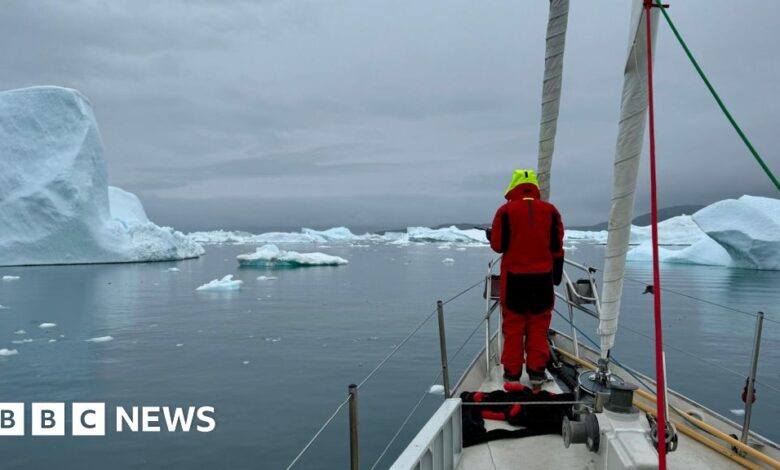
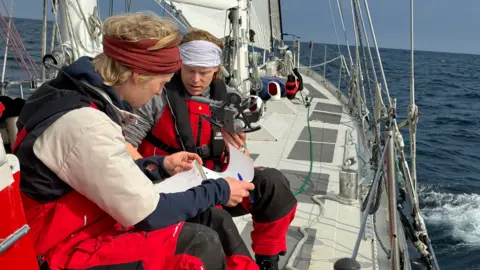 Northwest Passage Ocean Science Expedition
Northwest Passage Ocean Science Expedition“There is no room for error,” says Isak Rockström. “Where we are now, the only help we can get is from a couple of Canadian Coast Guard icebreakers that patrol the entire Canadian Arctic.”
For the past two months, Isak, 26, and his brother Alex, 25, have been battling the freezing temperatures of the Arctic Circle together.
They traversed the dangerous, sometimes unfamiliar terrain of the Northwest Passage between the Atlantic and Pacific oceans, collecting new data on climate change in the region.
They faced icebergs and strong winds in Iceland.
A “tough situation”, as Isak puts it, occurred the day before they spoke to the BBC. While sailing through a fjord, they were caught in a 52mph (84kph) wind blowing from nearby mountains, pulling them towards shore.
“The wind was so strong that even with the engine running, we couldn’t go anywhere,” he recalled.
Off Devon Island, the world’s largest uninhabited island, they are at risk of running aground because the area has not been fully mapped.
They had to quickly rotate the other sails to get the wind in their favor and “disassemble some parts and makeshift assemblies” to lower the main sail, Alex said.
But Isak said the “most challenging sea crossing of my life” was the long journey around Greenland through thick fog and ice in the Davis Strait.
He said they felt as if they were “wading on and on… through high winds or fog”.
“Then one day the fog cleared and there was a little tunnel through the cloud in the distance – and we could actually see Greenland at last. And that was just a great confirmation that we weren’t going crazy.”
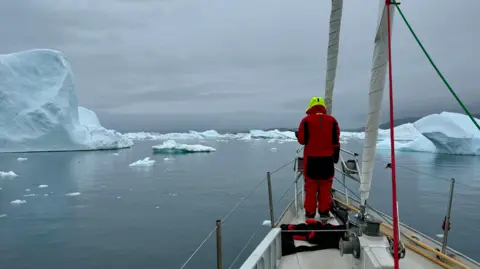 Northwest Passage Ocean Science Expedition
Northwest Passage Ocean Science Expedition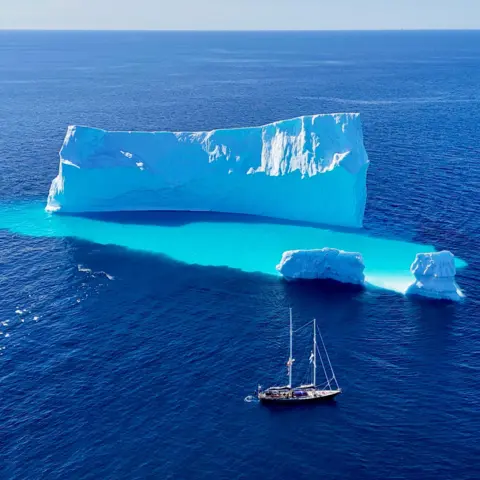 Northwest Passage Ocean Science Expedition
Northwest Passage Ocean Science ExpeditionOnly a handful of crew members are able to successfully complete this journey each year, and these two brothers are among the youngest ever to attempt it.
The BBC is interviewing them throughout the trip as they prepare to embark on one of the most challenging stages of their journey – one they both fear and look forward to.
Since setting sail from Norway in June, the crew of the Abel Tasman has circled Iceland and Greenland before entering the harsh waters between northern Canada and the Arctic.
They hope to reach their destination in Nome, Alaska in early October.
Captain Isak was a year older than Canadian Jeff MacInnis when he completed the expedition in 1988, at the age of 25. MacInnis is believed to be the youngest person to have successfully completed the expedition.
But they are experienced sailors – they sailed from Stockholm in Sweden to the west coast of Mexico in 2019.
As captain and first mate, they said sailing the 75-foot sailboat only strengthened their brotherly bond, as their small expedition team acted as a foster family.
“I don’t think we can get any closer than we are now,” said Isak.
“I think we really understand exactly how each other works and we don’t get on each other’s nerves,” Alex added.
Alex said that despite the perils of the journey, he had long wanted to travel through the Northwest Passage. He was intrigued by maps of the area and stories of previous expeditions, and by the realization that it could change due to climate change.
He recalled a night sailing trip off the coast of Greenland that he said would stay with him for the rest of his life.
“We were under the midnight sun, slowly moving past these giant icebergs, and the light was amazing as it shone through the icebergs… It was really beautiful.”
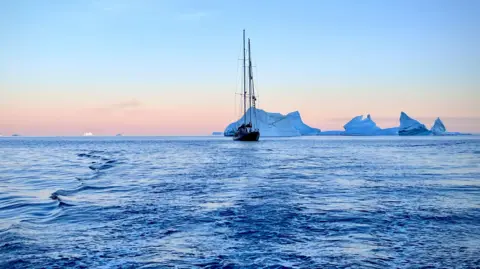 Northwest Passage Ocean Science Expedition
Northwest Passage Ocean Science Expedition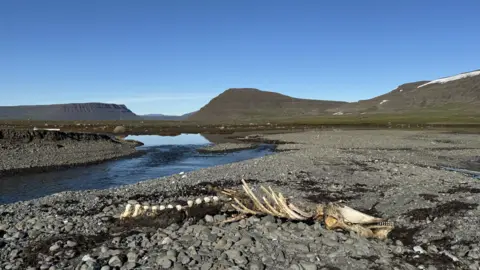 Northwest Passage Ocean Science Expedition
Northwest Passage Ocean Science ExpeditionIt took more convincing for Isak to make the trip. What convinced him was that “this is one of the few expeditions left that is truly an expedition,” combining danger and isolation, he said.
Keith Tuffley, the expedition’s overall commander – who quit his job at Citibank to join the trip and owned Abel Tasman – became a surrogate father to the Rockström family.
The Rockström family’s biological father, Johan, is a Swedish climate scientist who helped develop the concept of climate tipping points, when specific large-scale environmental changes are thought to become self-sustaining and irreversible beyond a certain threshold.
Part of the purpose of the expedition is to highlight how climate change is increasing the risk of reaching these tipping points, particularly some systems in the Arctic Circle.
Several studies have shown that parts of the Greenland ice sheet would be much more vulnerable to melting if global temperatures rose by 1.5–2 degrees Celsius above pre-industrial levels. However, the exact locations of such tipping points are highly uncertain, and a full-blown collapse could take thousands of years.
The Rockström family lived in Abel Tasman while studying climate physics at the University of Bergen, balancing their studies with expeditions.
While much of the data they collected will have to be sent back to a lab for analysis, Alex says the raw numbers from the seawater measurements they took show that the waters around Greenland are colder and less salty than before — a sign of ice melt.
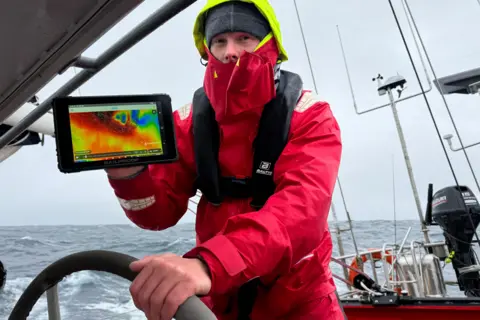 Northwest Passage Ocean Science Expedition
Northwest Passage Ocean Science Expedition Northwest Passage Ocean Science Expedition
Northwest Passage Ocean Science ExpeditionProfessor David Thornalley, an ocean and climate scientist at University College London, explains that over time, the freshwater flow from the Greenland ice sheet has the potential to weaken the main ocean current running along the Atlantic and have a major impact on climate.
Melting ice sheets also cause global sea levels to rise, increasing the risk of coastal flooding.
As well as potentially affecting the balance of marine ecosystems, melting ice can also create a feedback process, “where the meltwater causes ocean circulation to change, leading to warmer water flowing into glaciers that flow into the ocean, which in turn causes the glaciers to melt and retreat more rapidly,” said Professor Thornalley.
Alex hopes the data they collect along the Northwest Passage will be significant.
“I think it’s easy to underestimate the value of the data that can be collected from a sailing yacht like this… Big ships, big icebreakers, have a very limited range of operations.”
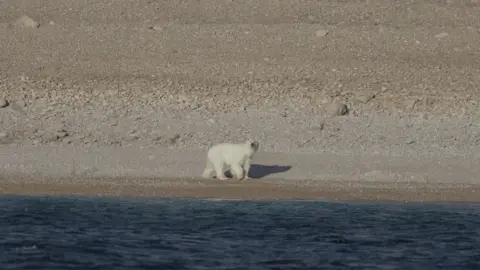 Northwest Passage Ocean Science Expedition
Northwest Passage Ocean Science ExpeditionThe Abel Tasman expedition still had a long and challenging journey ahead.
“Where we are now is one of those points on the trip where from day one we were a little bit apprehensive and very excited, because it was… the beginning of the really challenging part,” said Isak.
While melting Arctic ice makes it easier for ships to navigate the Northwest Passage, the icebergs it creates make the journey more “unpredictable,” said Tuffley, the expedition leader.
Sometimes, their surroundings seem completely alien.
“It looks like Mars,” Keith said of their anchorage, on Devon Island.
“It was desolate, rugged. It was red, like iron ore.”
Except for a few walruses and polar bears, the entire crew was alone.





